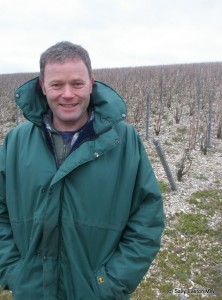Meonhill

Didier Pierson
Forget big, brand-name Champagne houses investing in the UK to make sparkling wine. Fifth generation Champenois vigneron Didier Pierson has already been growing grapes to make English Sparkling Wine (ESW) on the South Downs since 2004. He was the first, and he thinks, still the only Champenois investing in England. His Meonhill property is in Hampshire’s Meon Valley.
Pierson spent a year rummaging around the south coast of England “looking to find something similar to the Côte de Blancs in Champagne” he said, where his family vineyards are located, at Avize. He reviewed the English climate and weather, undertook soil analyses in various locatoins, and finally linked up in a joint venture with the non-wine-drinking owner of Little West End Farm, between Winchester and Petersfield. The South Downs Way skirts the farm.
The first plantings were in 2004 and 2005, and now amount to 4 hectares. Pierson’s first harvest was in 2007, but no wine was bottled. He kept it in vats until the 2008 came in. Pierson’s first ESW was bottled in 2009, a blend of the ’07 and ’08 vintages.
Pierson is well placed to explain the differences between Champagne and England. He said “the big difference is the weather. Summer is cooler in England. And flowering at the end of June can be cool, especially at night in England” where the temperature drops overnight. He added “in Champagne, flowering is usually in the first half of June, and the temperature is usually quite warm.” His South Downs field is also extremely flinty, right to the surface.
Such was the cold misery of the English summer in 2012, Pierson didn’t pick any grapes that year. He said “the sugar levels were too low, we didn’t even harvest. It’s the first time I’ve not done a harvest, even in Champagne.” So much for his inspiration for coming to England because he “wanted to do something different.” Not quite what he had in mind!

Wintry Meonhill Vineyard
The hillside he settled on is an exposed south-facing spur of downland just south of Old Winchester Hill. “Normally” Pierson said, almost grimacing at the memory of the 2012 vintage, “summer on the south-facing slope is warm. And there is some wind almost all the time, which constantly dries the leaves.” All of which means he has less disease pressure on the South Downs than in Champagne.
Pierson’s four hectares are divided equally between pinot noir and chardonnay. He replicates the 50:50 proportion in his reserve cuvee.
Wines are kept on lees for three years. (Non-vintage Champagne only requires 15 months). Pierson said “I’d like to add [even] another year on lees, because the more you keep wine on lees the better the autolysis. You get more complexity.” Less freshness too, but freshness isn’t an issue in England. Pierson said “there’s more freshness in England [than Champagne] – less sugar, more acidity – and this needs to be controlled otherwise the wine will be too crispy.” Keeping the wine on lees for longer is one way to control the freshness – “there are more aromas with more time on lees, and the acidity will lower, slowly” he explained.
The idea is to plant a total of 12 hectares over the next five to ten years. Pierson already has his eye on turning out the sheep from the adjacent field.
His Champagne is called Pierson-Whitaker, and that was pretty tasty too, based on the tasting with his English bubblies.
Tasting, in situ, February 2013
Meonhill Reserve NV, ~£22
50% chardonnay, 50% pinot noir. Three years on lees.
Vinous, steely nose, with upright backbone on the palate and steely, briar, hawthorn and hedgerow notes. Very fresh, linear, savoury-mealiness and dry-toast notes in nicely layered flavours. Fine, persistent mousse. Notable weight and body from the pinot noir proportion. Fresh, steely. Good length.
Meonhill Chardonnay NV, ~£23
So ‘blanc de blanc’, but Pierson wants to keep it English (though ‘blanc de blanc’ is mentioned on the back label). Three years on lees.
Citrus creamy nose, with perky palate attack, toasted lemons, and good intensity of rich sweet-lees/brioche thing on the palate. Fine, persistent mousse. Fresh, and with some roundness/plushness on the citrus-led mid palate. Good.
For availability of these wines contact Meonhill directly via the website.
Comments
2 Responses to “Meonhill”




February 28, 2013 at 12:29 pm
Available locally at Fareham Wine Cellar too!
February 28, 2013 at 1:41 pm
Great news! Thanks Dominic.